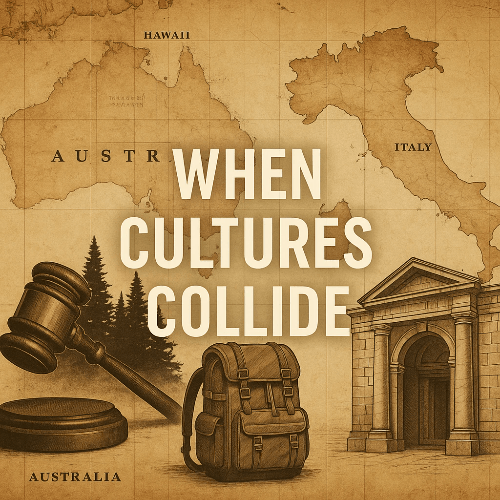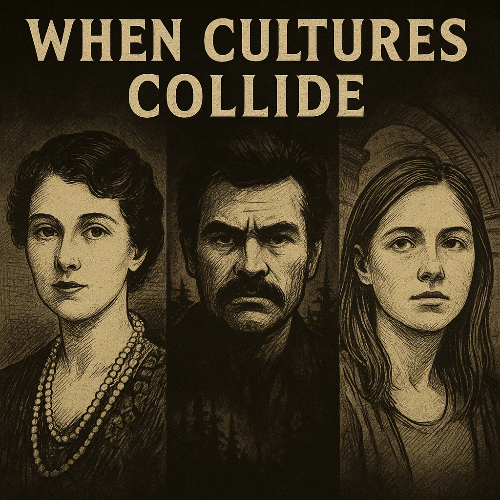
The Thalia Massie Case
In 1931, a young Navy wife stumbled onto a dark Honolulu road claiming she had been brutally attacked. Within hours, five local men from mixed ethnic backgrounds were behind bars. What followed was a year of sensational headlines, vigilante violence, and a courtroom drama that revealed deep fractures between U.S. mainland power and Hawai‘i’s diverse island society.
This is the story of the Thalia Massie case — a true crime where justice, race, and colonial hierarchy collided.
The Assault That Sparked an Uproar
Thalia Fortescue Massie, wife of Lt. Thomas Massie of the U.S. Navy, emerged one September night in 1931 with a broken jaw and bruised face. At first she said she couldn’t identify her attackers. Later, she implicated “locals” and produced a license plate number that led police to five young working-class men: Horace Ida, Ben Ahakuelo, Joseph Kahahawai, Henry Chang, and David Takai.
Despite thin evidence and conflicting timelines, the press branded the men “thugs” and “fiends.” In the charged atmosphere of territorial Hawai‘i, many white mainlanders saw this as proof that local justice could not be trusted.
Cultural Context
Hawai‘i in the 1930s was a U.S. territory, not a state. Power lay with a haole (white) elite tied to the Navy and sugar interests. The local population was majority Native Hawaiian, Japanese, Chinese, Filipino, and mixed ancestry. For many, the Massie case symbolized a clash between imported mainland racial attitudes and Hawai‘i’s more complex, multiethnic reality.
A Hung Jury, A Deadly Retaliation
The trial ended in December with a hung jury after 97 hours of deliberation. Outraged Navy families viewed it as a miscarriage of justice. Soon after, sailors kidnapped and beat one of the accused in an attempt to force a confession.
On January 8, 1932, Thalia’s mother, Grace Fortescue, joined by Lt. Massie and two sailors, abducted Joseph Kahahawai from the courthouse steps. Hours later he was dead from a gunshot wound. The group was arrested while trying to dispose of his body.
Clarence Darrow and the “Honor Defense”
Enter Clarence Darrow, the famous defense attorney from the Scopes “Monkey Trial.” In the April 1932 trial, he argued the defendants had acted in a moment of uncontrollable rage to defend a woman’s honor.
The jury returned a verdict of manslaughter, and Judge Charles S. Davis sentenced the group to ten years. But the ink was barely dry before Territorial Governor Lawrence Judd commuted their sentence to just one hour served in his office — a shocking decision influenced by political and military pressure.
Legal Legacy
The Massie case remains a textbook example of unequal justice: five local men nearly convicted on dubious evidence, while four vigilantes served a symbolic punishment for a killing carried out in broad daylight. It exposed how race and power shaped the meaning of “justice” in colonial Hawai‘i.
A Case That Still Echoes
Kahahawai’s death devastated his family and community. The surviving defendants lived under suspicion for decades. Thalia’s credibility eroded over time, with many historians concluding her story was fabricated or exaggerated.
✦ If you’re fascinated by forgotten scandals and cultural collisions like this one, dive into my book Crimes That Time Forgot: History’s Most Notorious Cases Revisited ✦ — where I uncover more stories that history tried to bury.

Ivan Milat: The Hunter of Backpackers
In the early 1990s, Australia’s reputation as a paradise for young backpackers took a sinister turn. Travelers from Britain, Germany, and other countries began to vanish while hitchhiking along the Hume Highway near Sydney. What police eventually uncovered shocked not just Australia, but the world: a serial killer preying on foreigners far from home.
This chilling saga became known as the Backpacker Murders — a case that revealed the vulnerability of travelers and tested the trust between cultures in a country built on welcoming outsiders.
A Trail of Missing Tourists
Between 1989 and 1992, several young backpackers disappeared without trace. Among them were British friends Caroline Clarke and Joanne Walters, German travelers Anja Habschied and Gabor Neugebauer, and three young Australians who were hitchhiking the same routes.
The common thread? They were all budget travelers, relying on hitchhiking and cheap hostels — lifestyles that made them easy targets.
Cultural Context
Australia prided itself on being a safe, adventurous destination for international backpackers. The murders struck at the heart of this image, raising uncomfortable questions about how easily outsiders could be targeted and how local law enforcement could miss the patterns for so long. For many in Europe, headlines about missing tourists cast a long shadow over the carefree “gap year” dream.
The Discovery in Belanglo Forest
In 1992, two runners discovered bones in Belanglo State Forest, a remote, eerie woodland south of Sydney. Soon after, more bodies emerged. The grim tally eventually reached seven victims, all showing signs of torture, sexual assault, and execution-style killings.
The brutality — stabbings, gunshots, spinal injuries — suggested a sadistic predator who took pleasure in prolonging terror. Media coverage exploded worldwide, painting Australia’s bushland as a place of hidden menace.
Suspicion fell on Ivan Milat, a road worker from a large immigrant family with a history of violence. Police linked him to weapons consistent with the murders and to a British backpacker who had narrowly escaped his clutches years earlier.
In 1996, Milat was convicted on seven counts of murder and sentenced to life imprisonment without parole. He maintained his innocence until his death in 2019, but few doubted he was responsible for the killing spree.
Legal Legacy
The Backpacker Murders reshaped how Australia approached tourism safety. Hitchhiking plummeted in popularity, and governments promoted traveler awareness campaigns. The case became a cautionary tale for how modern crime intersects with global mobility — a stark reminder that wanderlust can collide with danger when least expected.
✦ For more stories where travel, culture, and crime intersect, explore my book Crimes That Time Forgot: History’s Most Notorious Cases Revisited ✦ — where forgotten crimes from around the world come back into the light.
________________________________________
The Amanda Knox Case (Italy, 2007)
When 21-year-old American student Amanda Knox moved to Perugia, Italy, for a year abroad, she expected romance, language study, and travel. Instead, she became the center of one of the most sensational true crime cases of the 21st century — a case that exposed the sharp differences between American and Italian justice, media, and cultural assumptions.
The Murder of Meredith Kercher
On November 1, 2007, British student Meredith Kercher, Knox’s roommate, was found murdered in their shared apartment. The brutal killing — throat slashed, signs of sexual assault — shocked the quiet university town.
Almost immediately, Knox and her Italian boyfriend, Raffaele Sollecito, fell under suspicion. Their odd behavior in the days after the crime — kissing outside the crime scene, inconsistent statements — was read by Italian authorities as signs of guilt, while Knox later said she was simply confused and traumatized.
Cultural Context
In Italy, public stoicism and composure in the face of tragedy are often equated with dignity. Knox’s quirky demeanor, open affection with Sollecito, and awkward interviews clashed with cultural expectations. What many Americans saw as a frightened young woman, many Italians interpreted as coldness or deceit. This culture clash in perception became central to the case.
Trials, Media Frenzy, and Worldwide Division
Italian prosecutors painted Knox as a “Foxy Knoxy” femme fatale who orchestrated a drug-fueled sex game gone wrong. Tabloids seized the narrative, splashing her face across covers worldwide. The U.S. media largely defended her as a naïve student railroaded by an archaic legal system.
After a 2009 conviction, Knox spent four years in prison before the verdict was overturned in 2011. The rollercoaster continued: a retrial reconvicted her in 2014, only for Italy’s highest court to acquit her definitively in 2015.
Meanwhile, Rudy Guede, an Ivory Coast immigrant, was convicted based on DNA evidence and served 13 years for Kercher’s murder. Yet Knox and Sollecito remained entangled in years of legal battles.
At the heart of the Knox case was more than forensic evidence. It was about how justice itself is understood.
• In Italy, investigative judges play a prominent role and trials can be retried multiple times.
• In the U.S., the concept of “double jeopardy” would have barred retrial after acquittal.
• The reliance on circumstantial evidence and psychological profiling of Knox bewildered many American observers.
The case became a global mirror, reflecting not only two legal systems but also divergent cultural ideas about crime, gender, and morality.
Legal Legacy
The Amanda Knox case remains a cautionary tale about international travel, cultural misunderstanding, and trial by media. It exposed how foreigners in unfamiliar legal systems can become both suspects and symbols, trapped in battles larger than themselves. Today, Knox campaigns for criminal justice reform and speaks openly about her ordeal.
Why It Still Resonates
The case of Amanda Knox and Meredith Kercher remains one of the most debated crimes of modern times. Was Knox unfairly vilified because she didn’t “act” the way Italians expected? Was the international media circus itself an accessory to injustice?
The truth is that this case wasn’t just about what happened in Perugia that night — it was about what happens when cultures collide in a courtroom, and the whole world is watching.
✦ Want more stories where cultural misunderstandings twist the meaning of justice? Explore my book Crimes That Time Forgot: History’s Most Notorious Cases Revisited ✦ — and discover forgotten scandals that still echo today.
Blog written by Guy Hadleigh, author of Crimes That Time Forgot, the Macabre True Crimes & Mysteries Series, the Murder and Mayhem Series, the British Killers Series, the Infamous True Crimes and Trials Series - and many more!

